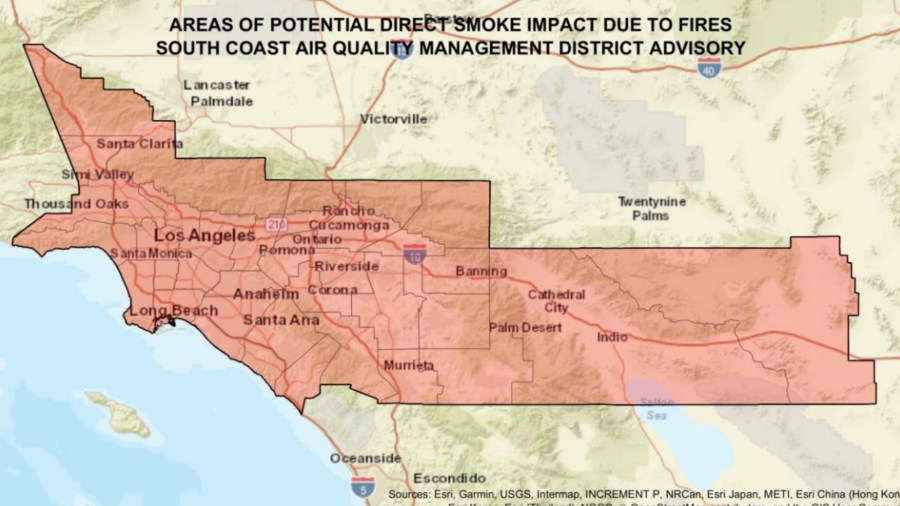As wildfires continue to ravage the West Coast Thursday, Southern California residents are being urged to prepare for another day of smoky, unhealthy air quality.
Los Angeles, Orange, Riverside and San Bernardino counties will all experience poor air quality due to smoke and ash from two major wildfires blanketing the region, as well as major blazes burning in the central and northern parts of the state, according to a news release from the South Coast Air Quality Management District.
While smoke will impact most of the region, the areas with the highest concentration of tiny, lung-damaging PM2.5 particles are closest to the Bobcat and El Dorado fires, which are burning respectively in the Angeles National Forest north of Azusa and near Yucaipa, the release stated.
Because of the smoke and ash, the Los Angeles County Department of Public Health issued an advisory, warning that air quality will be unhealthy in the following areas:
- Central Los Angeles County
- Southeast Los Angeles County
- West San Fernando Valley
- East San Fernando Valley
- West San Gabriel Valley
- East San Gabriel Valley
- Pomona-Walnut Valley
- South San Gabriel Valley
- South Central Los Angeles County
- San Gabriel Mountains
The smoke advisory is in effect until at least Friday.
“It is difficult to tell where smoke, ash or soot from a fire will go, or how winds will affect the level of these particles in the air, so we ask everyone to remember that smoke and ash can be harmful to health, even for people who are healthy,” said L.A. County Public Health Officer Dr. Muntu Davis.
Everyone should avoid outdoor exposure as much as possible and limit physical exertion — regardless of whether it’s inside or outside.
Adults and children with health conditions such as asthma, heart disease or other respiratory diseases are urged to stay indoors and limit outdoor activities.
“If you can see smoke, soot, or ash, or you can smell smoke, pay attention to your immediate environment and take precautions to safeguard your health. These precautions are particularly important for children, older adults, and people with heart or lung diseases,” Davis said.

Through mid-day Thursday, areas south of the Bobcat Fire will likely see the highest PM2.5 readings. That includes the 210 Freeway corridor from Pasadena to Rancho Cucamonga, according to SCAQMD.
By the afternoon, as the Santa Ana winds fade, smoke is expected to shift toward the west and could impact the Santa Clarita Valley.
Smoke and ash will have a more modest — but still likely noticeable — effect in southwest L.A., Orange and southwest Riverside counties, according to the district, which noted that the Bobcat Fire in particular has been “producing substantial amounts of smoke.”
In the Inland Empire, the El Dorado Fire is generating smaller plumes of smoke, which will primarily affect the area between Yucaipa and Banning throughout the day. The San Bernardino Valley and possibly the Coachella Valley will be impacted later in the evening.
In addition, windblown dust advisories have been issued for Riverside and San Bernardino counties.
But health officials are primarily concerned about small particles found in wildfire smoke, which can cause a range of effects, including burning eyes, runny nose, headaches, scratchy throat and even illnesses like bronchitis. In individuals with respiratory illnesses and other sensitive conditions, the particles can cause more serious issues, including difficulty breathing and chest pain.
The L.A. County Public Health Department has a number of guidelines to help keep people safe and healthy when air quality is poor. They include:
- Avoiding unnecessary outdoor activity if you see or smell smoke or ash in the air.
- Keeping indoor air as clean as possible by closing windows and doors, and running air conditioning that recirculates air within the home to keep harmful particles out. Air filtration devices with HEPA filters can further reduce particles indoors.
- Not using air condition units that draw air only from outside or do not have a recirculating option.
- Avoiding use of fireplaces, candles and vacuums, using damp cloths to clean dusty surfaces indoors instead.
- Don’t smoke.
People who have symptoms of lung or heart disease that may be related to smoke exposure should call a doctor or go to an urgent care center immediately, or, if it’s life-threatening, call 911. Symptoms to look out for include severe coughing, shortness of breath or difficulty breathing, wheezing, chest tightness or pain, palpitations, nausea or unusual fatigue or lightheadedness, according to the health department
Residents can prepare for potentially bad air quality by signing up to for alerts at AirAlerts.org.





















